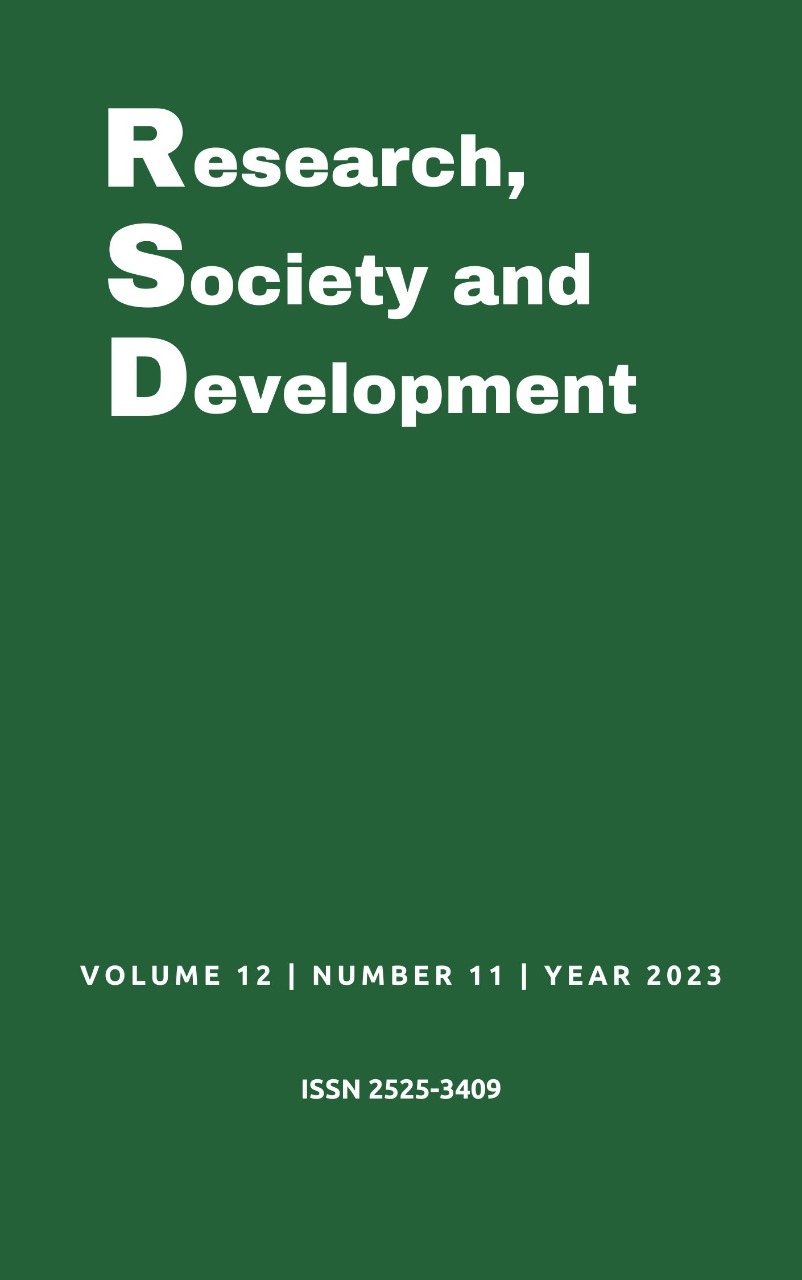Benigne paroxistic positional vertigo and relationship with low vitamin D
DOI:
https://doi.org/10.33448/rsd-v12i11.43528Keywords:
Benign paroxysmal positional vertigo; Vitamin D; Vitamin D deficiency.Abstract
Introduction: Hypovitaminosis D is related to an increase in the otoconia degeneration marker, contributing to benign paroxysmal positional vertigo (BPPV). Objective: to show whether or not there is a relationship between BPPV and low vitamin D. Methodology: narrative type review, to delimit the search, combinations of descriptors were used: “Benign paroxysmal positional vertigo x vitamin D”, “Paroxysmal positional vertigo benign x hypovitaminosis D” and “benign paroxysmal positional vertigo x vitamin D replacement”, in the following databases: Scientific Electronic Library Online (SciELO), Google Scholar, ResearchGate and National Library of Medicine (PubMed). Results and discussion: BPPV is a disease that alters balance and is most often idiopathic, with advanced age, head trauma, disorders affecting the inner ear and female gender as other predisposing factors. Its relationship with vitamin D lies in the fact that this vitamin regulates calcium and phosphorus and therefore acts on otoconia. Conclusion: Although there is no consensus, many studies associate hypovitaminosis D with BPPV.
References
Balatsouras, D. G., Koukoutsis, G., Fassolis, A., Moukos, A., & Apris, A. (2018). Benign paroxysmal positional vertigo in the elderly: Current insights. Clin. Interv. Aging, 2251–2266. (vol. 13).
Bazonini, J. A. (2016). Hipovitaminose D como fator de risco para a Vertigem Posicional Paroxística Benigna: estudo caso-controle. p. 63 Dissertação (Mestrado em Ciências da Reabilitação) – UEL/UNOPAR.
Büki, B., Ecker, M., Jünger, H., & Lundberg, Y. W. (2013). Vitamin D deficiency and benign paroxysmal positioning vertigo. Med Hypotheses.
Costa Dias, P., Garcia, H. F., & De Sousa, P. C. (2021). O papel da suplementação com vitamina D na Vertigem Posicional Paroxística Benigna. Acta Otorrinolaringológica Gallega. (14).
Ganança, M. M.; et al. (2005). Lidando com a vertigem posicional paroxística benigna. Acta OrL, 23(1), 18-25.
Hoyos et al. (2017). Vertigem posicional paroxistica benigna idiopatica comrecorrências: vitamina D e calcemia. Rev. Fed. Argent. Soc. Otorrinolaringol: 24(3): 48-52.
Libonati, G. A., Leone, A., Martellucci, S., Gallo, A., Albera, R., Lucisano, S., Bavazzano, M., Chiarella, G., Viola, P., Galletti, F., Freni, F., Ciodaro, F., Marcelli, V., Tortoriello, G., di Santillo, L. S., Picciotti, P. M., Galli, J., Vitale, S., Quaranta, N., Cavallaro, G., Gamba, P., Teggi, R., Cangiano, I., Faralli, M., Barboni, A., Messina, A.; & Graziano, G. (2022). Prevenção da Vertigem Posicional Paroxística Benigna Recorrente: O Papel da Suplementação Combinada com Vitamina D e Antioxidantes. Audiol. 445-456.
Marom, T., Oron, Y., Watad, W., Levy, D., & Roth, Y. (2009) Revisiting benign paroxysmal positional vertigo pathophysiology. Am J Otolaryngol. 250-255.
Maslovara, S., Butkovic Soldo, S., Sestak, A., Milinkovic, K., Rogic-Namacinski, J., & Soldo, A. (2018). D3 levels, incidence and recurrence of different clinical forms of BPPV. Braz J Otorhinolaryngo.
Holick, M. F.; et al. (2011), Evaluation, treatment, and prevention of vitamin D deficiency: An endocrine society clinical practice guideline, J. Clin. Endocrinol. Metab., 96(7), 1911–1930.
Jeong, S. H., & Kim, J. S. (2019). Impaired Calcium Metabolism in Benign Paroxysmal Positional Vertigo: A Topical Review. J. Neurol. Phys. Ther. 43, S37– S41.
Silva, A. L. S., Marinho, M. R. C., Gouveia, F. M. V., Silva, J. G., Ferreira, A. S., & Cal, R. (2011). Vertigem Posicional Paroxística Benigna: comparação de duas recentes diretrizes internacionais. Braz. j. otorhinolaryngol.
Souza, E. C. F. (2015). Prevalência da deficiência e insuficiência de vitamina D na vertigem posicional Paroxística benigna idiopática. HSPM.
Su, P., Liu, Y.C., & Lin, H. C. (2016) Risk factors for the recurrence of post-semicircular canal benign paroxysmal positional vertigo after canalithrepositioning Authors. Journal of Neurology.
Talaat, H. S., Abuhadied, G., Talaat, A. S., Abdelaal, M. S. (2015) Low bone mineral density and vitamin D deficiency in patients with benign positional paroxysmal vertigo. Eur Arch Otorhinolaryngol. (June 29).
Torres, T. A. P. (2020) Relação entre os níveis de Vitamina D e a Vertigem Posicional Paroxística Benigna. Faculdade de Medicina de Lisboa. (abril).
Sreenivas, V., Sima, N. H., Philip, S. (2019). The Role of Comorbidities in Benign Paroxysmal Positional Vertigo. Ear, Nose Throat J., 0–5.
Wee, C. L., Mokhtar, S. S., Singh, K. K. B., Yahaya, S., Leung, S. W. S., Rasool, A. H. G. (2021) Calcitriol Supplementation Ameliorates Microvascular Endothelial Dysfunction in Vitamin D-Deficient Diabetic Rats by Upregulating the Vascular eNOS Protein Expression and Reducing Oxidative Stress. Oxid Med Cell Longev.
Yang, H., Zhao, X., Xu, Y., Wang, L., He, Q., Lundberg, Y.W. (2011). Matrix recruitment and calcium sequestration for spatial specific otoconia development. PLoS One.
Zuma e Maia, F. C., de Fraga, R. B., Ramos, B. F. Cal, R. V., Mangabeira Albernaz, P. L. (2019). Seasonality and solar radiation variation level in benign paroxysmal positional vertigo. Acta Otolaryngol. 139(6), 497–499.
Santos, C. M. C., Pimenta, C. A. M., Nobre, M. R. C. (2007). The PICO strategy for the research question construction and evidence search. Revista latino-americana de enfermagem, 15, 508-511.
Downloads
Published
How to Cite
Issue
Section
License
Copyright (c) 2023 Jordana Caroline Dias Silva; Letícia de Oliveira Araújo; Giovanna Ribeiro Amaral de Carvalho; Marcela Silva Lima

This work is licensed under a Creative Commons Attribution 4.0 International License.
Authors who publish with this journal agree to the following terms:
1) Authors retain copyright and grant the journal right of first publication with the work simultaneously licensed under a Creative Commons Attribution License that allows others to share the work with an acknowledgement of the work's authorship and initial publication in this journal.
2) Authors are able to enter into separate, additional contractual arrangements for the non-exclusive distribution of the journal's published version of the work (e.g., post it to an institutional repository or publish it in a book), with an acknowledgement of its initial publication in this journal.
3) Authors are permitted and encouraged to post their work online (e.g., in institutional repositories or on their website) prior to and during the submission process, as it can lead to productive exchanges, as well as earlier and greater citation of published work.

